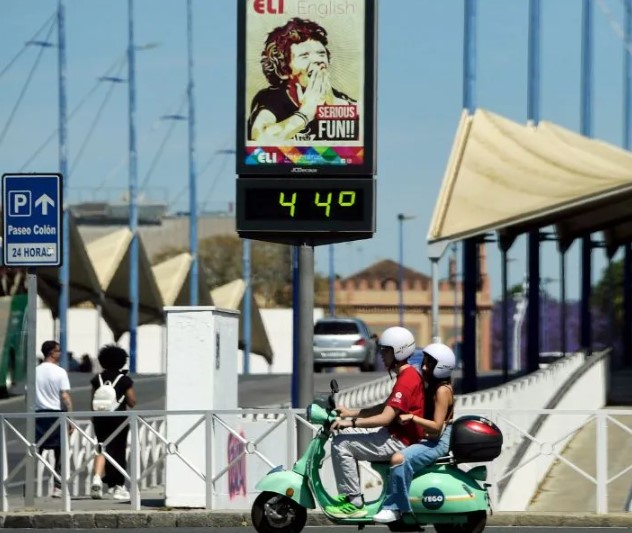Historic heat and drought trigger electric rationing in Mexico, Costa Rica, Ecuador and Colombia
By Alberta Quicler
The world has experienced eleven consecutive months of abnormally high temperatures, both in the air and on the surface of the oceans. In Latin America, several regions have suffered a series of debilitating power blackouts and suspension of drinking water service due to record temperatures and drought.

The temperature reached a record 44 degrees C. last week in Mexico City.
In Mexico, the government is urging citizens to cut back on energy consumption and water usage. “There was a demand that exceeded the generation capacity of energy,” said the Mexican President Andrés Manuel López Obrador at a Thursday press conference,
In recent days, blackouts have been recorded in the country’s capital and in other areas, such as Michoacán (west), Tamaulipas (northeast) and Campeche (southeast). In some of these regions the temperature exceeded 40º C. The entity responsible for the Mexican electrical system usually makes power cuts to balance supply and demand. The heat and accompanying drought caused the level of several dams in the country to reduce, causing concern in the productive sectors, mainly in agriculture.
A similar situation occurs in Costa Rica, where authorities announced that from Monday there will be energy rationing due to the scarcity of water in reservoirs in response to droughts caused by the El Niño climate phenomenon, authorities reported. Rationing will last a maximum of three hours per customer on an alternating basis. “This El Niño was really the most complicated in the history of Costa Rica,” said Roberto Quirós, director of the Costa Rican Electricity Institute (ICE), the country’s main energy supplier. “We are experiencing a drought we haven’t seen in 50 years,” said Berny Fallas, a hydroclimatology expert at ICE.
Costa Rica has a green energy matrix in which 99% of production comes from renewable sources. Of this clean production, 75% is generated in hydroelectric plants, which were affected by the lack of rain during the dry period (November-May). This will be the first energy rationing since 2007, when another El Niño also caused problems. The cuts will begin on Monday throughout Costa Rica, with a maximum of three hours per customer on an alternating basis. Hospitals, health centers, basic services and industry will not be affected, according to ICE.
The blackouts will have an indefinite duration and will depend on the amount of water that falls in the coming weeks. The rainy season runs from May to November although the first two weeks of May have been exceptionally dry. ICE recommended that the population make responsible use of electricity and not waste its consumption, since reservoirs are at critically low levels.
Ecuador and Colombia have imposed similar suspensions of electric service with Colombia rationing drinking water in some areas. Only in the past two weeks has the level in hydroelectric reservoirs in the country’s southern region began to recover from record low levels. Officials in both countries are cautiously optimistic but worry about what will happen with the dry season begins in June.
11 months of abnormal temperatures
Large areas of Central and South America have set high temperature records since June of last year. In Ecuador, the high-altitude Andean cities of Quito and Cuenca have set all-time records of 28 and 29 degrees Celsius (83 and 84 Fahrenheit) respectively, with Cuenca setting new daily high temperature records on 54 days in the past year.
 Not only are Latin America countries suffering from the heat and impacts of the El Niño. The entire world has suffered the consequences.
Not only are Latin America countries suffering from the heat and impacts of the El Niño. The entire world has suffered the consequences.
According to the European observatory Copernicus, the world has experienced almost a year of abnormally high temperatures, both in the air and on the surface of the oceans, despite the weakening of El Niño. Ocean surface temperatures broke a monthly record in April, with an average of 21.04°C outside areas close to the poles, marking the thirteenth consecutive monthly record. The globe has been recording an abnormal average temperature since June last year. April 2024 is no exception, with an average temperature of 15.03°C, which is 1.58°C higher than an average April in the pre-industrial era (1850-1900).
“Although unusual, a similar series of monthly records was already observed in 2015/2016,” Copernicus noted. Over the past twelve months, the global temperature has been 1.61°C higher than in the pre-industrial era, exceeding the 1.5°C limit set by the Paris agreement.
However, this anomaly needs to be observed on average over several decades to consider that the climate has reached this critical threshold. April was the second hottest April on record in Europe, as well as March and the entire winter period. “Each additional degree of climate warming is accompanied by extreme weather events, both more intense and more likely”, recalled Julien Nicolas.
Recent weeks have been marked by waves of extreme heat in Asia, from India to Vietnam, while southern Brazil has suffered devastating floods. However, in terms of precipitation, Copernicus identifies no clear trends for April, reporting significant contrasts across the world. The month was wetter than normal for much of the Europe, but drier in the south of the continent and in parts of the Balkans and Russia. The situation is similar outside Europe: in much of North America, Central and East Asia, the Persian Gulf and southern Brazil, intense rains caused flooding, which continued into May.
In most of Latin American, around the Caspian Sea and across much of Australia, drought has predominated.
“El Niño reached its peak at the beginning of the year,” notes Julien Nicolas, which could explain a decrease in certain values: in April, the air temperature anomaly is less pronounced than in March, compared to the pre-industrial, and the ocean surface temperature is less warm than in March.
“Projection models indicate a possible transition to La Niña conditions in the second half of the year, but conditions are still quite uncertain”, Nicolas says. La Niña is the opposite of El Niño, producing opposite effects. However, the departure of El Niño will not alter the fundamental trend of warming caused by human activity. “This phenomenon overlaps with long-term trends that persist and are directly related to warming due to the increase in concentrations of greenhouse gases in the atmosphere and the amounts of heat that are absorbed and stored, especially in the oceans”, highlights Nicolas.
________________
Source: Jovempan
























